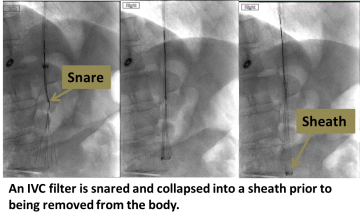IVC Filter Removal
Find your care
Our clinic is nationally and internationally renowned for IVC filter removal. Call 310-481-7545 to learn more about the IVC Filter Clinic at UCLA Health.
Treatment for:
IVC filter which is no longer needed
Why it’s done:
IVC filters can be protective against pulmonary embolism, but can also cause long-term complications such as thrombosis, fracture or migration. Thus, it is preferable to remove IVC filters which are no longer needed.
How it’s done:
An interventional radiologist uses ultrasound to access the jugular vein at the neck. A snare is used to engage the hook at the top of the filter, and a sheath is passed over the filter to collapse and remove it. Sometimes more advanced maneuvers are required for filter removal.

Level of anesthesia:
Conscious sedation or general anesthesia
Risks:
Bleeding, IVC thrombosis, infection
Post-procedure:
Two to three hours of bed rest, then discharge home the same day
Follow-up:
None required